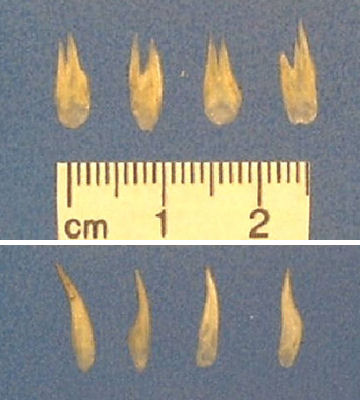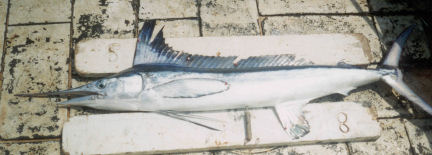Marlin Crash May Be Worse Than Reported
As a child, I frequently sat transfixed whenever adventure-television shows offered films of long fights between deep-sea anglers and tarpons, sailfish, or marlins. Tension would build as the angler tired yet the fish—dozens of pounds of twisting muscle—would daringly (to my young mind) breach the surface in its struggle to break free. Invariably, however, the fish lost.


Off camera as well, these fish have been losing for years—not only in contests with recreational anglers but even more dramatically in showdowns with commercial, mechanized fishing fleets. Stocks of many of these magnificent natural predators of the high seas languish at a fraction of the size needed for their populations to sustain themselves.
Among such animals are Atlantic white marlins (Tetrapturus albidus). A 2002 assessment of their population—the most recent one available—showed that the stock of these heavily overfished animals was 82 percent below the size that biologists would consider healthy and sustainable.
In fact, a new study hints that the 2002 assessment may have been unduly optimistic because many of the fish counted as marlins could have been a distantly related relative—the roundscale spearfish (Tetrapturus georgii).
Dead ringers for white marlins, the roundscale’s very existence had been dubious, notes Mahmood S. Shivji, director of Nova Southeastern University’s Guy Harvey Research Institute Oceanographic Center in Dania Beach, Fla. He observes that a single report published more than 30 years ago recounted features of four fish that appeared to characterize a distinct species. No research on the roundscale spearfish ever followed.
Now, Shivji and his Guy Harvey colleague Jennifer E. Magnussen have coauthored a genetic analysis of various billfish species with researchers from the National Marine Fisheries Service (NMFS). This report establishes conclusively not only that roundscale spearfish exist, but also that they constitute a genetically distinct species from other billfish, even the white marlins that they closely resemble.
Particularly worrisome, the authors note, is that the 16 roundscale spearfish analyzed for the new study were pulled from waters that constitute part of the white marlin’s range.
The tipoff
Shivji credits George Hinteregger of NMFS, one of the new report’s authors, with rediscovering the roundscale spearfish. Roughly a decade ago, Hinteregger was an observer on a commercial fishing vessel that hauled on board a slightly strange-looking white marlin. Hinteregger “had the foresight to bring [the dead fish] back to the lab,” says Shivji.
There, another scientist recalled a 1974 paper by C.R. Robins purporting to describe a new billfish. When the NMFS scientists looked back at Robins’ description, they found a few subtle features consistent with Hinteregger’s fish but not white marlins. Chief among these features were novel scales.
Marlins have thin-but-sturdy scales that are flat at their bases, where they join a fish’s body. The bases of scales from the new fish were consistent with the animal’s common name: They were rounded. They were also soft and pliable, and each scale had several small appendages, giving it a feathery feel.
Also, as Robins had noted, the new fish had an anus-to-anal-fin distance of a different proportion to its anal-fin length than did the white marlin, Shivji says.
Over the next 10 years, NMFS scientists found another 15 of these anomalous fish among the unintended hauls of commercial tuna and swordfish fleets operating in coastal and mid-ocean waters. Shivji, a geneticist, then compared DNA from these animals with that from white marlins, longbill spearfish, striped marlins, sailfish, black marlins, and Mediterranean spearfish.
Without question, the new analyses showed, DNA from the roundscale spearfish belongs to “a distinct evolutionary group unto itself,” says Shivji. The new species shares some ancestors with marlins, but only in the distant past, Shivji’s group reported in the November 2006 Bulletin of Marine Science.
What’s the big deal?
What’s wrong with finding a new species of billfish among white marlins? And how abundant can roundscale spearfish be if only 20 have been identified over the past 3 decades? Shivji acknowledges that the answers to those questions aren’t clear.
Without question, however, the stock of white marlins has crashed to where the fish is on the brink of being an endangered species, he notes. “The real problem,” Shivji told Science News Online, “is that we don’t know how many roundscale spearfish have been misidentified over time as white marlins—because until now, it would never have occurred to anyone that what they were catching were not white marlins.”
Shivji notes that by affixing satellite-monitored tags to some of the newly identified species, it should be possible to see how widely they roam. The four animals that Robins described were in the eastern Atlantic. The ones that the NMFS acquired came out of the western Atlantic. All were caught within the Northern Hemisphere.
“If you make the assumption that this species is like other billfish—like marlins, for instance, that are known to migrate large distances—then the roundscale spearfish might also [cross oceans],” Shivji says. At a minimum, that could have broad and potentially international implications for managing billfish stocks in the future. The new findings also alert fisheries managers that their already dismal tallies of white marlins might actually be overoptimistic.
If you would like to comment on this article, please see the blog version.







